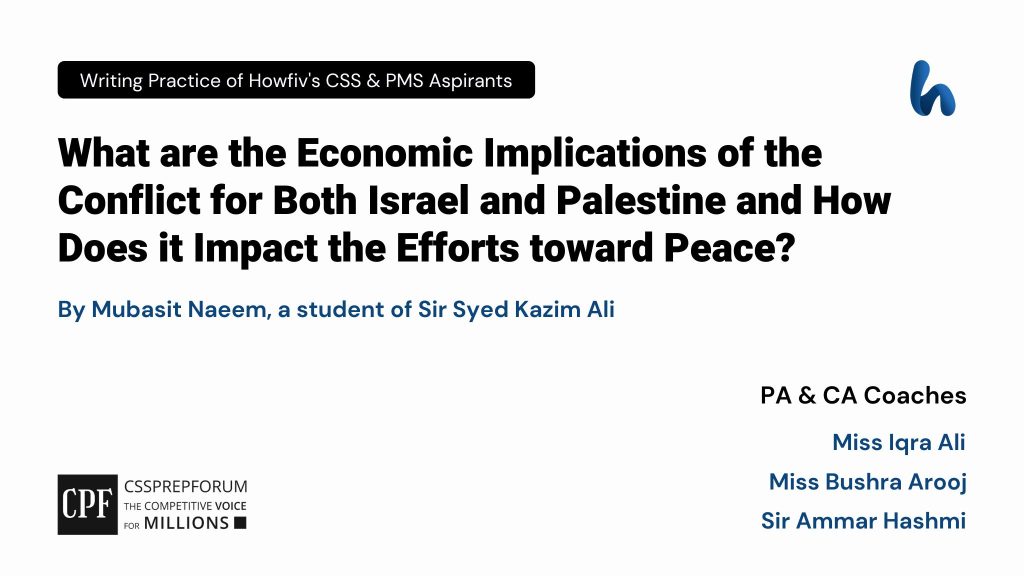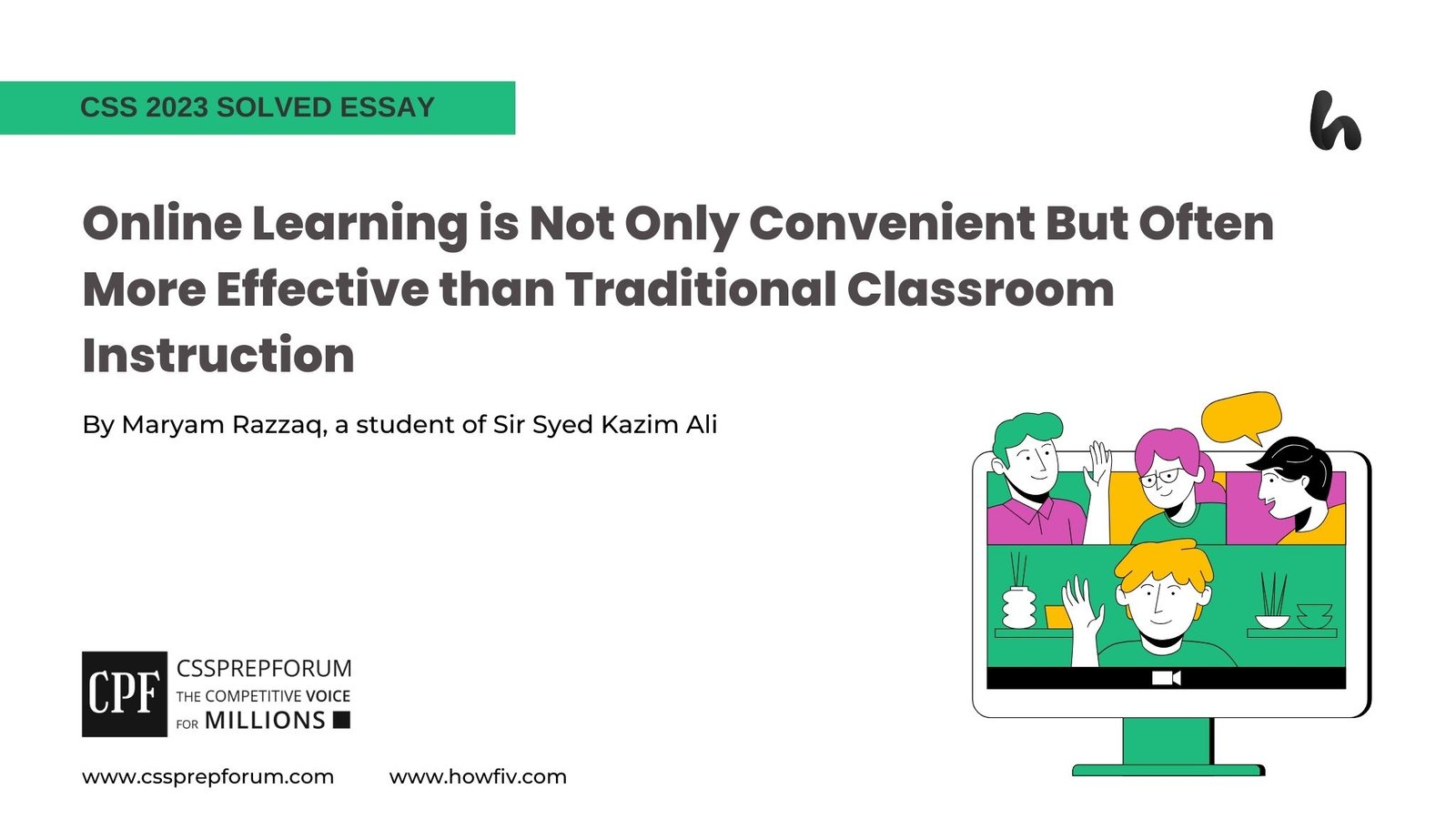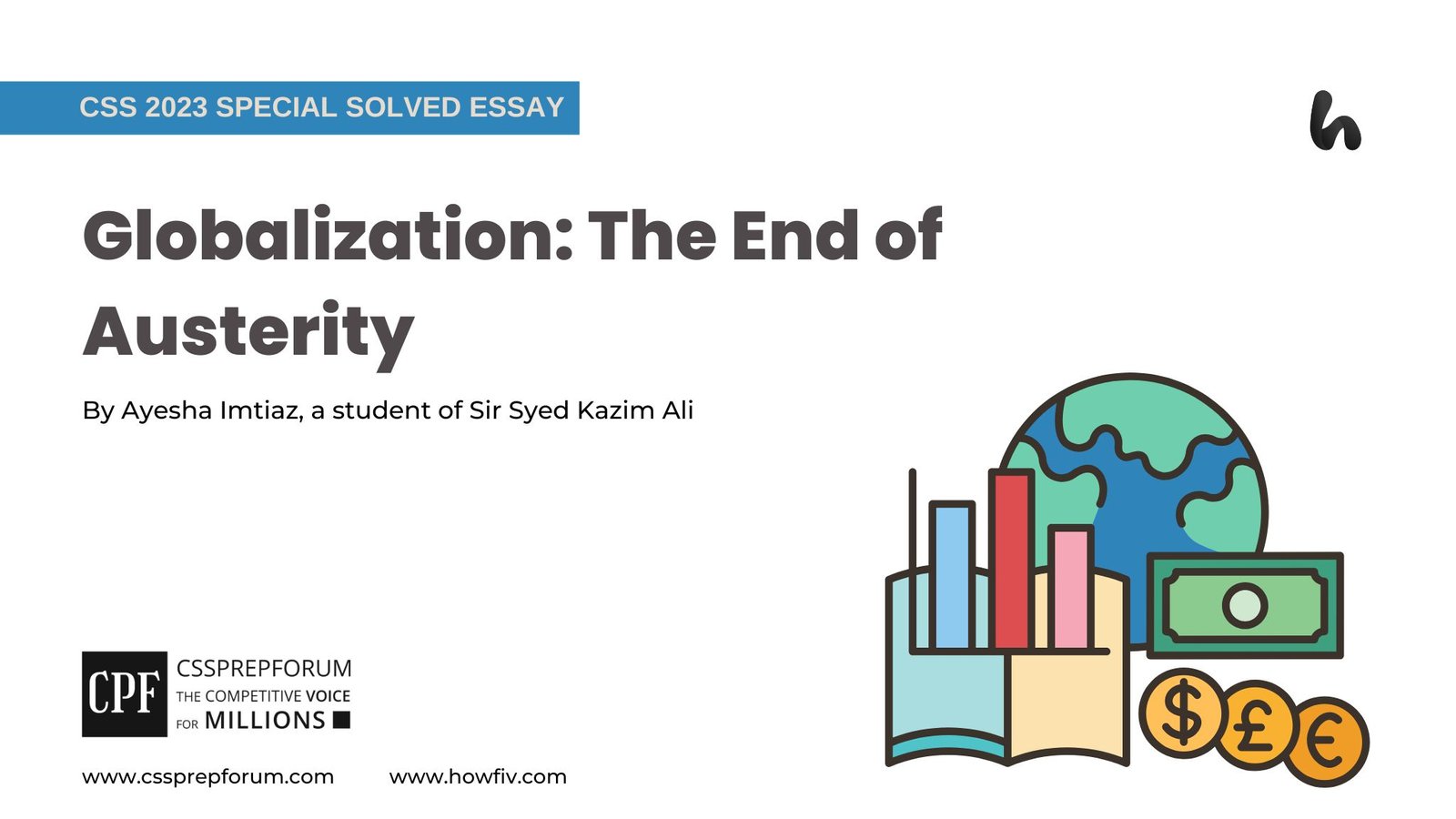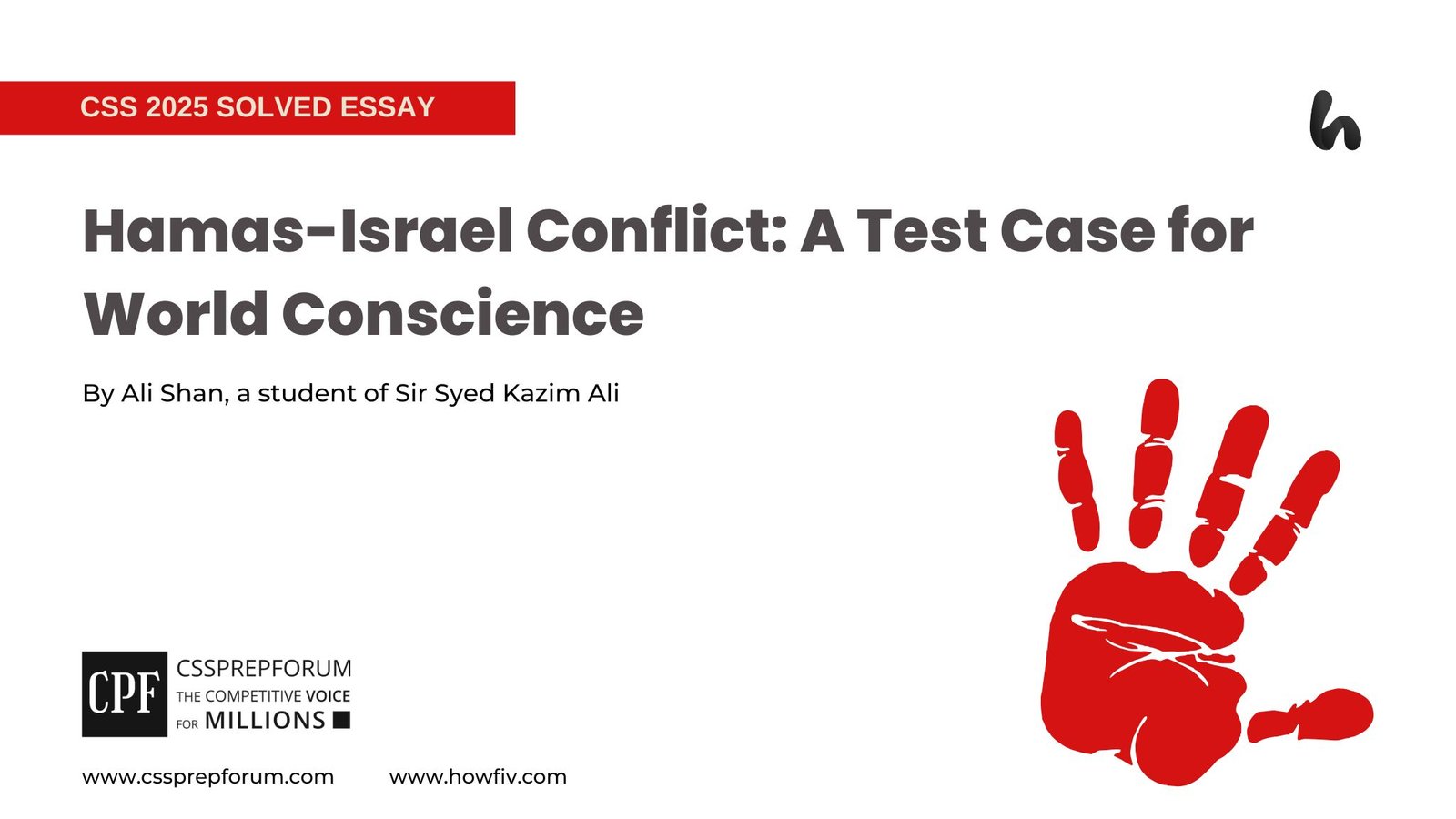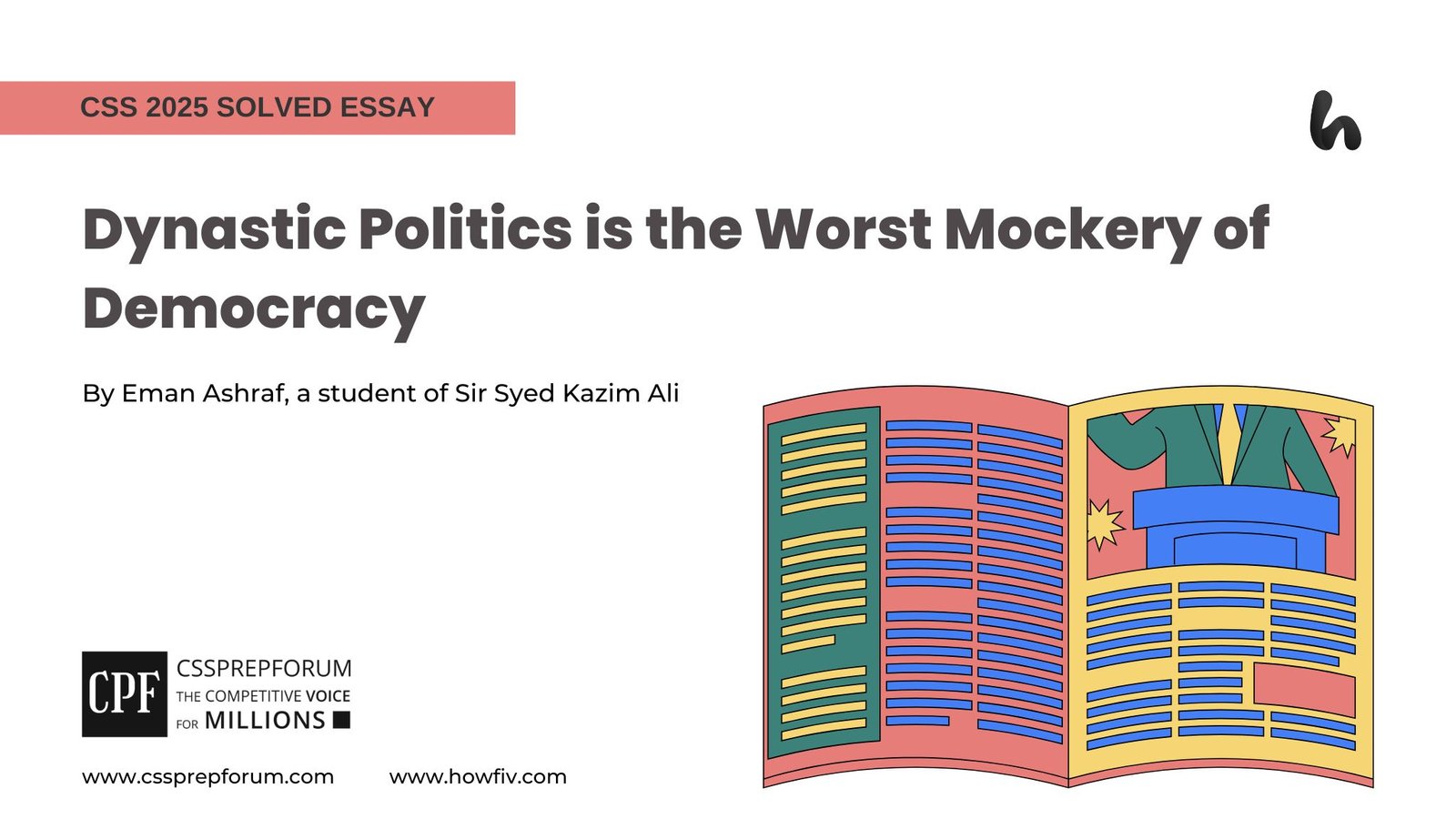CSS Current Affairs | Economic Implications of the Israel-Palestine Conflict
The following question of CSS Current Affairs is solved by Mubasit Naeem under the supervision of Howfiv’s Pakistan Affairs and Current Affairs Coaches. She learnt how to attempt 20 marks question and essay writing from Sir Syed Kazim Ali, Pakistan’s best CSS and PMS English essay and precis teacher with the highest success rate of his students. This solved past paper question is attempted on the pattern taught by Sir to his students, scoring the highest marks in compulsory and optional subjects for years, and uploaded to help aspirants understand how to crack a topic or question, how to write relevantly, what coherence is, and how to include and connect ideas, opinions, and suggestions to score the maximum.

Outline
1- Introduction
2- An overview of the conflict between Israel and Palestine
3- Economic implication for Palestine
- ✓Economic volatility
- Evidence: According to a World Bank report, Palestine’s economy largely depends on agriculture, which accounts for 6 per cent of GDP, 3 per cent of tourism, and more than 80 per cent of foreign aid.
- ✓Infrastructural damage
- Evidence: According to a United Nations report, the estimated loss of infrastructural damage to Gaza and the West Bank is $18.5 billion.
- ✓ Economic blockade and restriction
- Case in point: according to the International Labor Organization, there are 27000 permits issued to the people of Gaza and the people of the West Bank to work in Israelian territory.
4- Economic implications for Israel
- ✓Trade and economic disruption
- Evidence: According to the RAND Corporation, an estimated loss of $2.5 billion in 2014 and the recent Gaza war.
- As reported by the World Bank, there was $369 million in damage to the economy in the May 2021 conflict only.
- ✓Massive defence spending and military operations
- Case in point: according to the Stockholm International Peace Research Institute, Israel is consistently allocating 5.6% of its GDP to defence spending.
- According to the Institute for National Security Studies, Israel spent billions of dollars in different operations, such as around $2.5 billion in Operation Protective Edge in 2014.
- ✓Decline in the Tourism industry:
- Evidence: According to the Israel Bureau of Statistics, tourist arrivals have declined 26% in the last five years compared to 2014.
5- Impacts on efforts towards peace
- ✓Economic hardships fuel hostility
- Evidence: breaking of the OSLO accord and rise of non-state violent actors (Hamas) along with winning of rightest parties in the political arena (Likud)
- ✓The lack of a sovereign economy attracts powers to foster their interest
- Case in point: Israel solely got $ 4 billion in military aid in regard to this conflict, and 80% of the Palestinian economy runs on foreign assistance (World Bank)
- ✓Missed opportunities for regional corporations that can foster peace
- ✓Evidence: Proposed IMEC and Ben Gurion canal.
6- Critical analysis
7- Conclusion

Answer to the Question
Introduction
The longstanding conflict between Israel and Palestine has profound economic implications that significantly impact the peace efforts between them. It damages both entities with a great loss by shadowing the economic growth and decline in annual GDP growth. Moreover, it casts colossal infrastructural damage along with an unbearable humanitarian crisis. On a broader scale, the powerful one (Israel) has to spend more on defence spending, which hinders economic activities and becomes a main cause of neglect in development projects. Furthermore, this conflict not only topples economic activities but also makes the other sectors shrink, like the tourism industry and directly affects the people of that particular region. These economic challenges perpetuate the cycle of violence along with the long-lasting impact on sustainable peace as part of any lasting resolution.
An overview of the conflict between Israel and Palestine
The Israel-Palestine conflict is a deep-rooted struggle primarily over land and national identity. It began in the early 20th century between Jews and Arab populations in British-controlled Palestine. The conflict intensified after the creation of the Jewish state in 1948, which led to the displacement of hundreds of thousands from Palestine. Subsequent wars, notably in 1967 and 1973, Israelian settlements, territorial disputes, and security concerns with stalled peace efforts have led the cycle of violence and deepened the behaviours of mistrust on both sides.
Economic implication for Palestine
- Economic volatility:
Palestine, for no sure, has badly affected by this conflict, and fear of being collapse as a state is always knocking at its door. Primarily, the conflict fosters political instability that, combined with Israeli atrocities, has made the economy stagnant and highly volatile. According to the World Bank Report 2022, the Palestinian economy largely depends on agriculture, which accounts for 6% of the gross domestic product, and, most importantly, on foreign aid, which accounts for 80%. As we know, access to water resources and fertile land are the key ingredients to boost agricultural efficiency. Israelian settlements and control over water channels have imposed a devastating threat to this sector. Furthermore, dependency on foreign aid always causes the economy to get temporary relief. As a result, all these indicators make Palestine into a deep vicious cycle of economic instability.
- Infrastructural damage:
The conflict between Palestinian Arabs and Jews has witnessed four wars since 1948. War brought a lot of destruction, which flooded the Palestinian economy with colossal damage to infrastructure. For instance, the United Nations reported that the infrastructural loss to Gaza was in major chunks, and the West Bank was $ 18.5 billion. Ultimately, this damage put the already deprived economy in a state of no breath at all.
- Economic blockade and restriction:
Israel is always, with the support of the global hegemon (USA), making plans to wipe out the identity of Palestinians as a nation and in the economic arena. Luckily, Israel, as a winner in all wars that happened, made it to restrict Palestinians in the Gaza Strip and the Western Bank. Limited access to natural resources and controlled economic activities has made the Palestinian economy just to live as dependent. Moreover, people are scrutinized over their travel and business deals. For example, the International Labor Organization stated in its report that only 27000 permits were issued by the Israeli authorities to the people of Gaza and the people of the West Bank to work in Israelian territory. As a result, it had a leading effect on the shrinking of the economy of Palestine.
Economic implications for Israel:
- Trade and investment disruption:
States of unrest and wars always give rise to economic damage and severe consequences over a period of time. Though Israel is in a winning position, it also has paid a heavy price in terms of loss to its trade and disruption in investments. According to the Research and Development Organization (RAND, Israel faced an estimated $2.5 billion loss in its trade in 2014 and the recent Gaza war collectively. Other institutions, like the World Bank, stated that there was $ 369 million in damage to the Israeli economy only in 2021. Regardless of the support of big economic giants, conflict is leaving its print over Israel’s economy over a period of time.
- Massive defence spending and military operations:
Being in a state of war and its imperialistic policies, Israel is always using a stance of right to defend. That’s why it always spends a large portion of its GDP on massive defence spending. For instance, the Stockholm International Peace Research Institute stated that it consistently spends 5.6% of its GDP on defence, primarily on surveillance and defence equipment like the Iron Dome defence system. To maintain its rit, different military operations are carried out by the Israeli authorities over a period of time. This results in the fetching of budgets from different sectors for military spending. According to the Institute for National Security Industries, Israel spent around $2.5 billion in 2014 on Operation Protective Edge. Exuberant spending on military needs has been made possible by other sectors, and ultimately, the economy suffers.
- Decline in Tourism industry:
After the Yup-Kippur War of 1967, Israel captured most of Jerusalem and most of the land of Palestine. Palestine was established in the late bronze age, so it is inundated with prints of historical events. The most important city, Jerusalem, is a sacred place for all Christians, Muslims, and Jews. Moreover, different tourist spots like the Dead Sea make it a favourite destination for travellers all over the globe. Because of ongoing conflict and chaos in this region, people are hesitant to visit, and as a result, it has badly affected the tourism industry. For instance, the Israel Bureau of Statistics stated that there has been a 26% decline in the arrival of tourists in recent years as compared to 2014. It clearly indicates that it hinders the flow of cash, which results in the suffering of the economy at large.
Impacts on efforts towards peace:
- Economic hardships fuel hostility:
Economic hardships lead to various societal issues that provide more oxygen to the burning cause of mistrust between Palestine and Israel. Moreover, it brings in the rise of non-state actors like Hamas and PLO to address the grievances of the Palestinian people. At the Israeli end, the rightest Jewish parties were witnessed coming into power. It manifests a stronger Jewish agenda against Palestine. For instance, the end of the Oslo Accords is a recent example of severe hostility between them. To achieve a permanent solution to this conflict, both parties have to act prudently to tackle this menace.
- Lack of sovereign economy attracts powers to foster their interest:
In the past, countries were governed and controlled by military might, but in the modern world, it is done by acumen of economic trap or dependency. According to a realistic approach, countries act according to their interest. In this regard, Palestine and Israel’s conflict is also becoming a battleground for different world powers. In fact, the World Bank Report 2022 stated that 80 per cent of the Palestinian economy is dependent on foreign aid, and Israel solely got $4 billion in military aid from the USA. Lack of sovereign economies hinders peace talks, develops more vested interest of donors, and halts any peace deals further.
- Missed opportunities for regional corporations that can foster peace:
Economic implications have bound authorities to invest in cooperative projects in the region. The more cooperation or dependency appears, the more peace will flourish in his region. For example, the Ben Gurian Canal project and IMEC can bring prosperity to this region with the economic integration of Palestine and Israel economies. By addressing economic laps, both parties can make peace that prevails at large.
Critical analysis
The ongoing conflict between Israel and Palestine has profound economic implications that deeply impact peace efforts. For Palestine, it is almost at an alarming end with massive destruction in all aspects, especially at the economic and societal levels, particularly in Gaza, where the high rate of unemployment and blockade affects the whole population. Moreover, trade barriers and controlled mobility further exacerbate the edge of destruction. For Israel, this conflict brings more international defame with high spending on military operations, defence systems and personnel personnel training. Furthermore, it also has an adverse effect on trade and economic growth and makes him play the hand of interest of the global hegemon. This results in a deadlock in the dialogue between two suffering parties and promotes further hostility and a narcist mentality.
Conclusion
In conclusion, the economic implications have significantly impacted both Palestine and Israel and impede peace efforts. Palestine, for sure, has paid a large price for this conflict as compared to Israel, which has the support of a global economic giant. Only through comprehensive political and economic negotiation and intervention can a true sense of resolving conflict bring peace in this region that benefits both Israelis and Palestinians.

CSS Solved Past Papers’ Essays
Looking for the last ten years of CSS and PMS Solved Essays and want to know how Sir Kazim’s students write and score the highest marks in the essays’ papers? Then, click on the CSS Solved Essays to start reading them.
CSS Solved Essays
CSS Solved General Science & Ability Past Papers
Want to read the last ten years’ General Science & Ability Solved Past Papers to learn how to attempt them and to score high? Let’s click on the link below to read them all freely. All past papers have been solved by Pakistan’s top CSS GSA coach having the highest score of their students.
General Science & Ability

